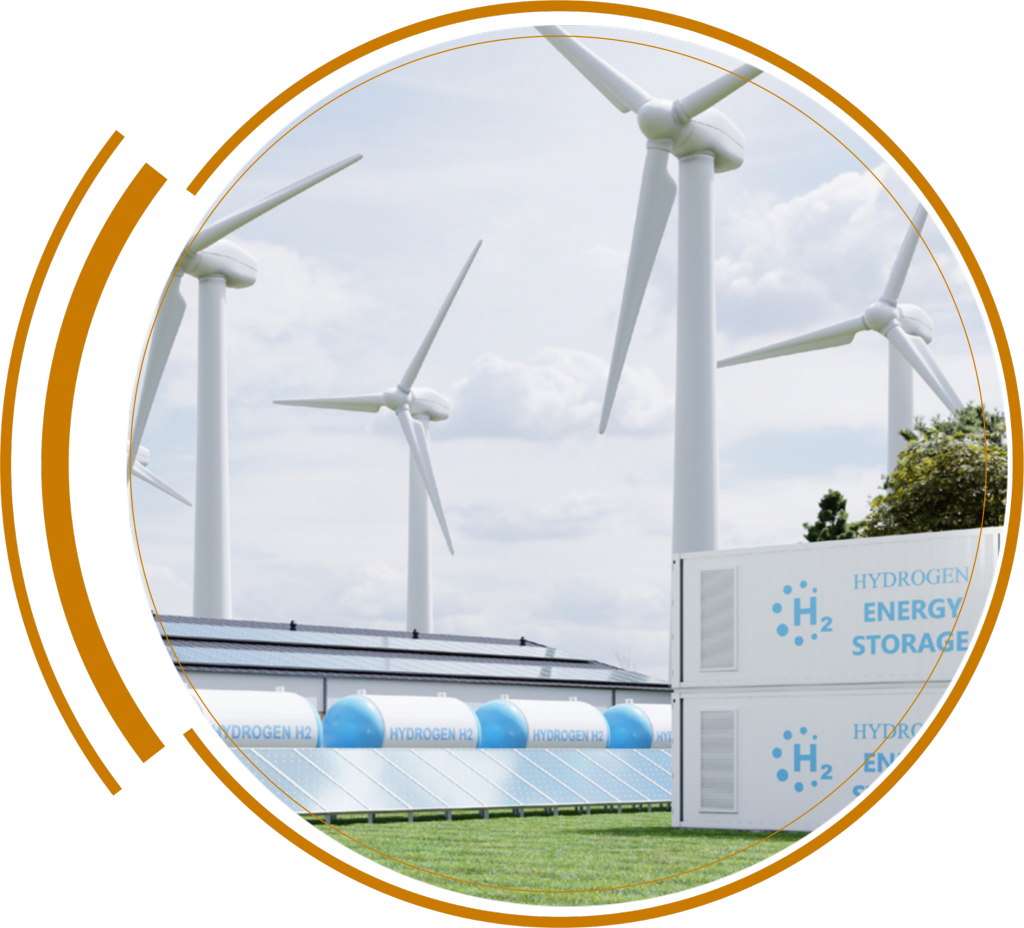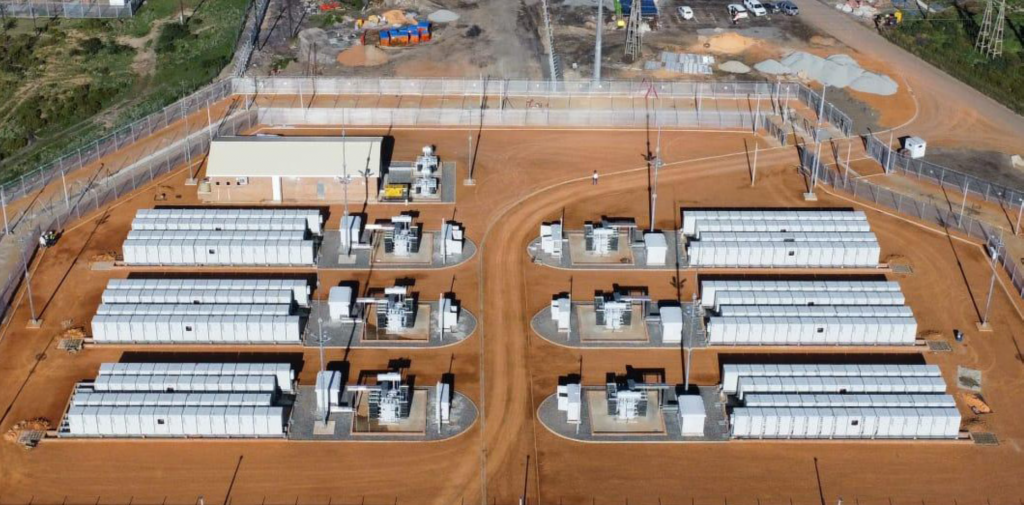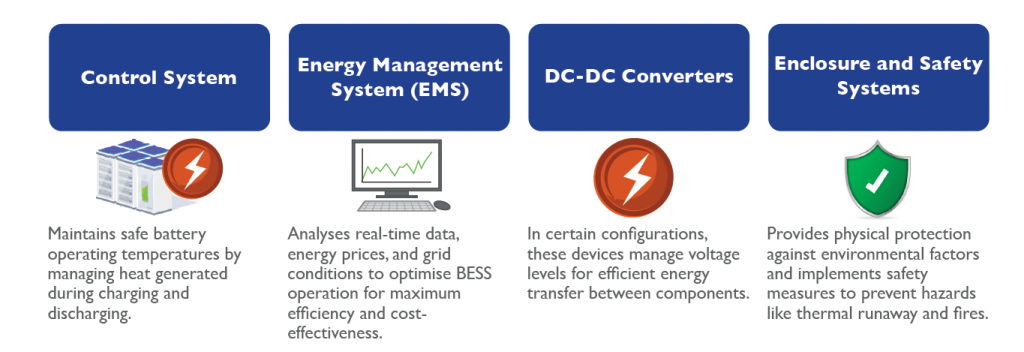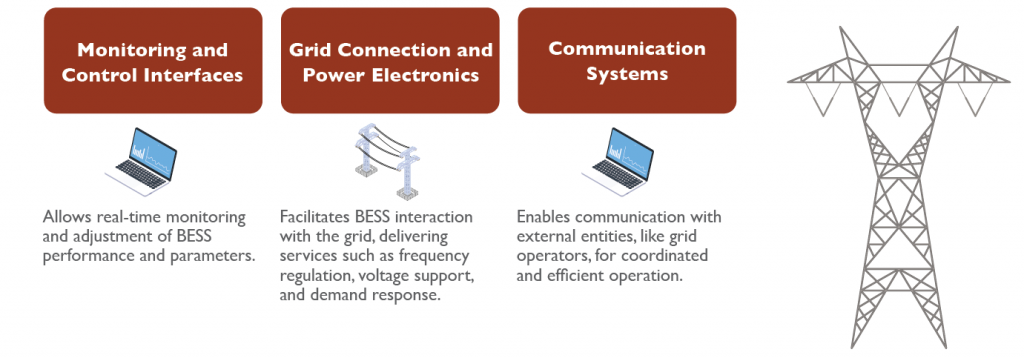
Battery Energy Storage Systems (BESS) is one of Distribution’s strategic programmes/technology, aimed at diversifying the generation energy mix, by pursuing a low-carbon future to reduce the impact on the environment. Eskom has taken the necessary steps to ensure the successful implementation of the Battery Energy Storage Systems (BESS) programme. This is a direct response to the urgent need to address South Africa’s long-running electricity crisis by adding more generation capacity to the grid and strengthening the grid by adding more storage and transforming capacity megawatt-hours. Currently, the Eskom BESS rollout programme is the largest to be implemented in South Africa.
BESS, or Battery Energy Storage Systems, stores electricity in batteries for on-demand power supply. The phrase “battery system” encompasses battery design, engineering, and deployment. Various energy sources like gas, nuclear, wind, and solar can charge BESS, making it crucial for stabilising grids and enhancing renewable energy reliability.
Through BESS, Eskom aspires to enable the integration of distributed energy resources, and pursuing a low-carbon future to reduce the impact of greenhouse gas emissions on the environment. The 1440 megawatt-hours (MWh) distributed BESS with 360 megawatt (MW) Solar Photovoltaic (PV) represents a giant leap forward in achieving this aspiration.


Eskom BESS rollout project is the largest to be implemented in Africa. This is a direct response to the urgent need to address South Africa’s long running electricity challenges, by transforming and strengthening grid capacity through battery energy storage.
The technology comprises several components that work together to enable its functionality, tis includes:




BESS Projects that Eskom will be investing in:
Phase 1: 199MW of the total planned 833MWh
Name | Province | MW Output | Daily MWh Capacity | Total Annual Energy (MWh) | Solar PV |
Skaapvlei | WC | 80 | 320 | 116 800 | |
Melkhout | EC | 35 | 140 | 51 100 | |
Elandskop | KZN | 8 | 32 | 11 680 | |
Pongola | KZN | 40 | 160 | 58 400 | |
Hex | WC | 20 | 100 | 36 500 | |
Graafwater | WC | 5 | 30 | 10 950 | |
Paleisheuwel | WC | 9.5 | 45 | 16 425 | |
Rietfontein | NC | 1.54 | 6.16 | 2248.4 | 2.04MW |
Total Phase 1 |
| 199.04 | 833.16 | 304 103 |
|
As per the latest schedule, phase 1 is anticipated to be completed by December 2023. Phase 2: 144MW/ 616MWh
Project Name | Province | MW Output | Daily MWh Capacity | Total Annual Energy (MWh) | Solar PV |
Witzenberg | WC | 17 | 68 | 24 820 | 0 |
Ashton | WC | 17 | 68 | 24 820 | 0 |
Cuprum | NC | 70 | 280 | 102 200 | 0 |
Kiwano | NC | 40 | 200 | 73 000 | 58MW |
Total Phase 2 |
| 144 | 616 | 224 840 | 58MW |
Eskom has taken the necessary steps to ensure the successful implementation of the BESS project. Through the BESS project, Eskom aspires to diversify the existing generation energy mix by pursuing a low carbon future in order to reduce the impact on the environment. The 1440MWh distributed BESS with 60 MW Solar PV represents a giant leap forward in achieving this aspiration, as it will be one of the largest BESS projects to be developed and implemented in South Africa.
BESS, or Battery Energy Storage Systems, stores electricity in batteries for on-demand power supply. The phrase “battery system” encompasses battery design, engineering, and deployment. Various energy sources like gas, nuclear, wind, and solar can charge BESS, making it crucial for stabilising grids and enhancing renewable energy reliability.
Eskom’s investment in Battery Energy Storage Systems aligns with several strategic goals for enhancing grid stability, accommodating renewable energy, providing ancillary services, and addressing network constraints
Renewable Energy
Integration:
BESS seamlessly integrates with renewable energy sources, optimising their utilisation, minimising waste, and bolstering grid reliability. This approach aligns with Eskom’s goals of maximising renewable energy integration and efficient resource management. BESS stores excess energy during high generation periods and releases it during low renewable energy output, ensuring continuous power supply.
Environmental Impact:
Integrating energy storage with renewables aids in reducing greenhouse gas emissions and promotes sustainable energy practices.
Network Constraints and Congestion Relief:
BESS swiftly addresses grid challenges like under voltages, overloads, and reactive power deficits by injecting or absorbing power. It effectively alleviates network congestion during peak periods, significantly reducing technical losses.
Mitigating REIPP Curtailment:
BESS efficiently absorbs excess energy generated during low-demand periods, mitigating grid congestion and instability issues. Instead of curtailing renewable energy independent power producer (REIPP) output, which results in energy wastage, BESS provides a more economically viable solution.
Ancillary Services:
BESS contributes ancillary services such as frequency regulation, voltage support, and reactive power control, enhancing grid reliability and power quality.
Efficiency Improvements and Distribution Investment Deferral:
BESS improves overall grid efficiency by reducing technical losses associated with long-distance power transmission. It can locally dispatch stored energy, reducing the necessity for extensive energy transfers and infrastructure upgrades.
Future-Proofing:
Eskom’s adoption of energy storage technologies like BESS prepares it for the evolving energy landscape characterised by decentralised generation, distributed energy resources, and smart grid technologies.
Grid Stability:
BESS offers rapid power output adjustments critical for grid stability, responding to supply and demand fluctuations, minimising outages, and ensuring reliable power delivery.
Peak Demand Management and Flexibility:
BESS manages peak demand by discharging stored energy during high consumption hours, reducing grid strain and the need for costly peak power plants. Eskom gains flexibility in energy resource management through BESS investment.
Maintenance Involves a blend of proactive monitoring, planned maintenance, potential component replacements, and technological advancements. Scheduled inspections follow manufacturer guidelines and operational experience, addressing physical and operational issues, ensuring safety, and cleaning components. BESS typically includes self-diagnostic tools that monitor system performance, identifying components requiring maintenance or replacement as they deteriorate. As battery cells degrade, individual cells or entire packs may need replacement based on diagnostic data.
Maintenance and operational practices for BESS are expected to advance with improving technology, increasing efficiency, and reducing costs.
A Battery Energy Storage System (BESS) comprises several fundamental components that work together to enable its functionality. Here are some key components:
- Battery Packs: These are the core components of a BESS, consisting of multiple individual rechargeable batteries. The batteries are organized into packs, each designed to store and release energy efficiently.
- Inverter: The inverter is responsible for converting the direct current (DC) output from the batteries into alternating current (AC) that can be used to power electrical devices and be connected to the grid.
- Battery Management System (BMS): The BMS monitors and manages the performance, state of charge, and state of health of individual batteries within the packs. It ensures that each battery operates safely and optimally, preventing overcharging, undercharging, and thermal issues.
- Cooling and Thermal Management: As batteries can generate heat during charging and discharging, a thermal management system, often involving cooling mechanisms, ensures that the batteries maintain a safe and efficient operating temperature.
- Control System: This system oversees the overall operation of the BESS, including energy flow, charge and discharge cycles, and grid interactions. It ensures that the BESS responds appropriately to grid signals and operational requirements.
- Energy Management System (EMS): The EMS optimises the operation of the BESS by analysing real-time data, energy prices, and grid conditions to make decisions about when to charge and discharge the batteries for maximum efficiency and economic benefit.
- DC-DC Converters: In some BESS configurations, DC-DC converters are used to manage the voltage levels within the system, allowing for efficient energy transfer between different components.
- Enclosure and Safety Systems: The physical enclosure of the BESS provides protection against environmental factors and safeguards against potential hazards. Safety systems include measures to prevent thermal runaway, fire, and other safety risks.
- Monitoring and Control Interfaces: These interfaces allow operators to monitor the performance and status of the BESS in real-time. They also provide control options to adjust operating parameters as needed.
- Grid Connection and Power Electronics: These components enable the BESS to interact with the grid, providing services like frequency regulation, voltage support, and demand response.
- Communication Systems: These systems facilitate communication between the BESS and external entities, such as grid operators, to ensure coordinated and efficient operation.
Each of these components plays a vital role in ensuring the proper functioning of a BESS, enabling it to provide a wide range of services to the electrical grid, industries, and communities.
Yes. BESS discharges energy for a minimum of 4 hours.
A BESS site with a capacity of 200 MW/800 MWh holds a substantial amount of stored energy. This is equivalent to a single unit at Medupi Power Station running for an hour. The technology should be strategically placed within the grid, especially near weak points or areas with voltage and power quality challenges, to help boost grid performance in those critical locations.
